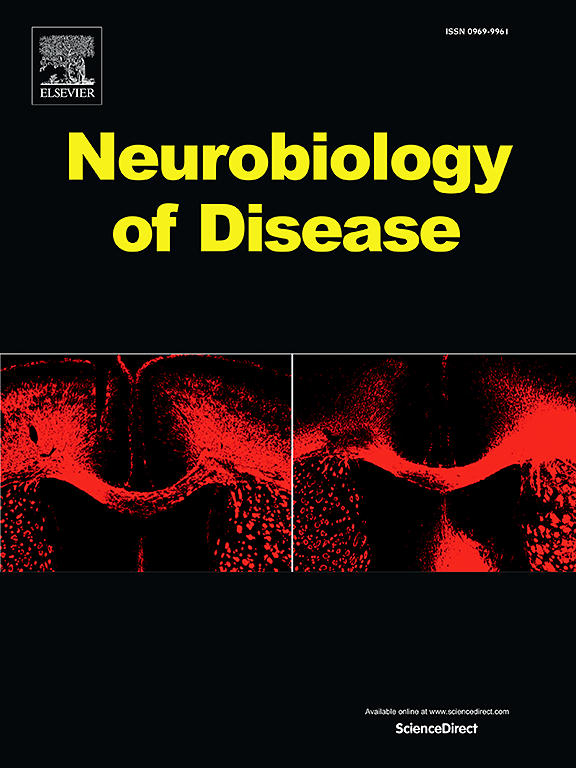Human iPSC-derived glutamatergic neurons with pathogenic KCNQ2 variants display hyperactive bursting phenotypes
IF 5.6
2区 医学
Q1 NEUROSCIENCES
引用次数: 0
Abstract
Pathogenic variants in the KCNQ2 gene, which encodes a potassium channel subunit, are associated with neonatal seizures, epileptic encephalopathy, intellectual disability, and autism. Although the consequences of disrupted KCNQ2 channel function have been studied in the past, the detailed molecular mechanisms underlying the development of neurological phenotypes remain unclear, and neuronal models of specific patient variants are lacking. We generated patient-specific induced pluripotent stem cells (iPSCs) from fibroblasts from three individuals with distinct KCNQ2 pathogenic variants. We corrected the KCNQ2 variants using CRISPR-Cas9 editing to create isogenic controls and differentiated these iPSCs into glutamatergic neurons to study the effects of each variant on neuronal function. The three KCNQ2 variants were: 1) KCNQ2 c.875_877delTCCinsCCT, L292_L293delinsPF, 2) KCNQ2 c.766G > T, G256W, and 3) KCNQ2 c.821C > T, T274M. Our data revealed longer neurite outgrowth in two patient lines (T274M and G256W). Transcriptional profiling showed that all three KCNQ2 lines co-expressed genes enriched in synaptic transmission/signaling, cell adhesion, and GTPase signal transduction. Functional analyses of neuronal networks revealed increased burst duration in all three KCNQ2 lines compared with their isogenic controls. Furthermore, neurons from the L292_L293delinsPF and T274M lines displayed increased network connectivity associated with increased density of synaptic markers. Finally, we detected hyperexcitable neuronal networks in the G256W line with electrical stimulation of the neural networks on a high-density microelectrode array, and this phenotype was rescued with retigabine. These disease-related phenotypes for each of the KCNQ2 pathogenic variants can be used for drug screening to identify treatment options for the patients.
具有致病性KCNQ2变异的人类ipsc衍生的谷氨酸能神经元显示出过度活跃的破裂表型。
编码钾通道亚基的KCNQ2基因的致病性变异与新生儿癫痫发作、癫痫性脑病、智力残疾和自闭症有关。尽管过去已经研究了KCNQ2通道功能中断的后果,但神经表型发展的详细分子机制仍然不清楚,并且缺乏特定患者变异的神经元模型。我们从三个具有不同KCNQ2致病变异的个体的成纤维细胞中生成了患者特异性诱导多能干细胞(iPSCs)。我们使用CRISPR-Cas9编辑来纠正KCNQ2变体,以创建等基因对照,并将这些iPSCs分化为谷氨酸能神经元,以研究每种变体对神经元功能的影响。三个KCNQ2变异分别是:1)KCNQ2 c. 875_877deltccincscct, L292_L293delinsPF, 2) KCNQ2 c.766G > T, G256W, 3) KCNQ2 c.821C > T, T274M。我们的数据显示两个患者系(T274M和G256W)的神经突生长更长。转录谱分析显示,这三个KCNQ2系共表达了突触传递/信号、细胞粘附和GTPase信号转导中富集的基因。神经网络的功能分析显示,与等基因对照相比,所有三个KCNQ2系的突发持续时间都增加了。此外,来自L292_L293delinsPF和T274M系的神经元显示出与突触标记密度增加相关的网络连通性增加。最后,我们在高密度微电极阵列上对神经网络进行电刺激,检测到G256W细胞系中的过度兴奋神经网络,并用雷沙滨挽救了这种表型。每种KCNQ2致病变异的这些疾病相关表型可用于药物筛选,以确定患者的治疗方案。
本文章由计算机程序翻译,如有差异,请以英文原文为准。
求助全文
约1分钟内获得全文
求助全文
来源期刊

Neurobiology of Disease
医学-神经科学
CiteScore
11.20
自引率
3.30%
发文量
270
审稿时长
76 days
期刊介绍:
Neurobiology of Disease is a major international journal at the interface between basic and clinical neuroscience. The journal provides a forum for the publication of top quality research papers on: molecular and cellular definitions of disease mechanisms, the neural systems and underpinning behavioral disorders, the genetics of inherited neurological and psychiatric diseases, nervous system aging, and findings relevant to the development of new therapies.
 求助内容:
求助内容: 应助结果提醒方式:
应助结果提醒方式:


